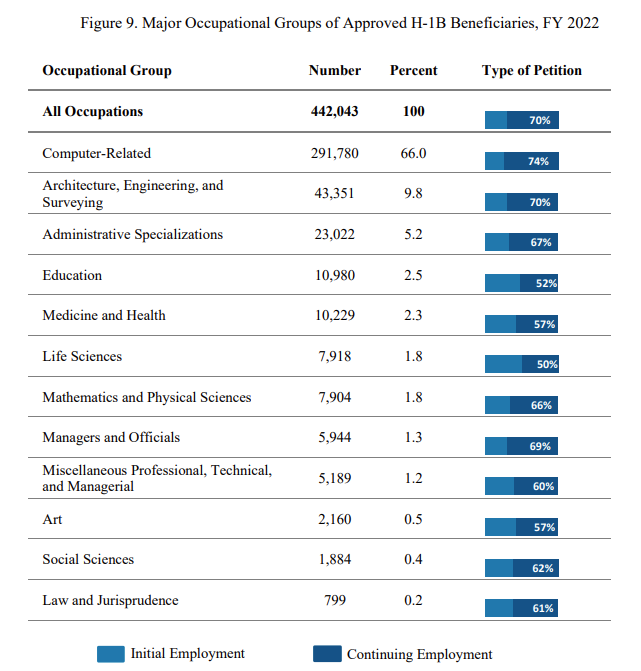Insight
September 28, 2023
H-1B Visa Holders: A Case Study for a Points-based Immigration System
Executive Summary
- The U.S. immigration system requires a more efficient legal pathway to citizenship for the more than 580,000 H-1B visa holders who are limited by the duration of their temporary visa and are not automatically converted to permanent residency once the visa expires.
- This population is an important source of labor as it has some of the most in-demand skills in the U.S. economy, but many are unable to obtain another legal status and opt to either return to their home country or seek out employment options in countries with simpler processes for permanent residency.
- Implementing a points-based legal immigration system would ensure a permanent citizenship pathway for these skilled immigrant workers and represent a significant step toward more effective employment-based immigration reform.
Introduction
There are approximately 580,000 H-1B visa holders in the United States, highly skilled and educated workers with in-demand skills the U.S. labor market requires, but they are nonetheless limited by the short length of their visa status. Once admitted for a three-year period, these workers are eligible for extension, but generally cannot maintain H-1B status for more than six years. After the H-1B visa expires, these individuals are not automatically converted to permanent residency. Many are unable to obtain another legal status and either return to their home country or seek out employment options in countries with simpler processes for permanent residency.
The loss of skilled visa holders is demonstrative of the United States’ deeper problem of being unable to retain productive foreign labor due to its outdated immigration system. Implementing a points-based legal immigration system would ensure a permanent citizenship pathway for these skilled immigrant workers and represent a significant step toward more effective employment-based immigration reform.
Immigration Pathway for H-1B Visa Holders
H-1B visa holders are highly skilled and educated foreign nationals who wish to work in specialty occupations. There are more than 580,000 of these individuals in the United States, all of whom are limited by the duration of the temporary visa. H-1B workers are generally admitted for a three-year period and are then eligible for a three-year extension. Upon visa expiration, these workers are not automatically converted to permanent residency and are required to find an alternative pathway to immigration or leave the United States.
Applying for permanent residency (a green card) is the most effective option for these workers who wish to continue living and working in the United States. For this population of workers, a green card can be acquired either through marriage or employment. In the case of an employment-based green card, the transition is not efficient as it requires employer sponsorship, is subject to green card caps, and can take years to obtain.
Most of this population, 85.5 percent of approved H-1B petitions, are Indian and Chinese nationals who tend to face longer wait times due to the caps on H-1B visas, decades-long visa backlogs, and country-based immigration quotas. Adjusting one’s status from an H-1B holder to a green card holder can take upwards of three years, the duration of the H-1B visa itself. Consequently, many H-1B workers must leave the United States while stuck in line for a status adjustment.
When forced to leave the United States, many of these workers either return to their home country or seek out employment opportunities in countries with simpler processes for permanent residency. This trend was recently highlighted by a new Canadian visa program designed specifically for individuals already holding American H-1B visas. Less than 48 hours after launching the program, 10,000 applications were filed, fulfilling Canada’s annual goal for the program.
H-1B Visa Holders Are an Important Labor Resource
According to the July 2023 Job Openings and Labor Turnover Survey (JOLTS), the United States has approximately 8.8 million job openings but only approximately 6.4 million unemployed individuals. Thus, there are 1.4 jobs for each native-born unemployed individual. This discrepancy has led many employers to turn to foreign labor to fill positions, yet they cannot rely on consistent and efficient access to this labor due to holes in the current employment-based immigration system.
H-1B holders are an important labor resource as they are highly skilled and educated. Employers are willing to pay for their labor but lose these workers to other countries due to the U.S. immigration system’s long wait times and backlogs.
These workers’ skills are directly applicable to industries with significant job openings. The following table shows the top 10 occupational groups for approved H-1B beneficiaries.
Table taken from the USCIS H-1B Characteristics Congressional Report FY2022
According to the USCIS H-1B Characteristics Congressional Report FY 2022, 81.7 percent of the approved H-1B beneficiaries work in a medical or science, technology, engineering, and math (STEM) occupation. The data highlight a promising labor pipeline that could fill the significant number of job openings in these fields.
According to July 2023 JOLTS data, the “health care and social assistance” industry has approximately 1.6 million job openings and makes up just over 18 percent of the total number of U.S. job openings. Without enough labor to staff these positions, these industries frequently suffer worker burnout due to long work hours and increased responsibilities. Meanwhile, in the STEM field, there is a shortage of semiconductor workers, software developers, and high-tech engineers, among other occupations.
The Case for a Points-Based System
By failing to create an efficient legal pathway to citizenship for H-1B visa holders, the United States is losing valuable immigrant labor. Implementing immigration reforms that prioritize economic factors such as human capital, skills, and entrepreneurship would be a significant step to ensure a permanent pathway to citizenship for skilled workers. The American Action Forum has proposed such a plan, under which permanent visas would be offered to highly skilled individuals based on a points system. Points would be acquired based on English proficiency, education levels, age, employment experience, U.S. labor demand, and other employment criteria.
Points-based immigration programs are already used by other countries, including Canada. After one year of full-time work experience in Canada, workers can apply for permanent residency, undergo a rating of their skills on a point system, and be accepted based on their potential to contribute to Canada’s economy.
A simpler points-based process, if implemented in the United States, would ensure H-1B holders have a path to citizenship and maintain a skilled foreign-born U.S. labor force to supplement native workers.
Conclusion
The loss of H-1B workers to other countries, either through visa expiration or their pursuit for simpler permanent residency processes, is a pertinent reminder that the U.S. legal immigration system needs patching. Many of these visa holders work in the medical and STEM fields, making them an important labor resource to fill job openings. Implementing a points-based immigration system would ensure a legal pathway to citizenship for these workers, a significant step toward effective immigration reform.











